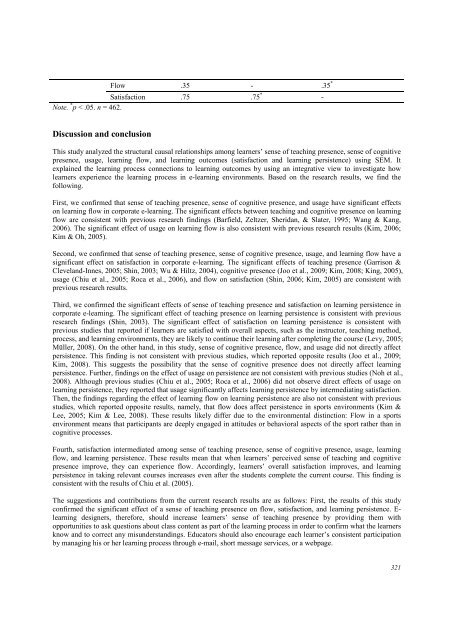Download Complete Issue in PDF - Educational Technology & Society
Download Complete Issue in PDF - Educational Technology & Society
Download Complete Issue in PDF - Educational Technology & Society
You also want an ePaper? Increase the reach of your titles
YUMPU automatically turns print PDFs into web optimized ePapers that Google loves.
Flow .35 - .35 *<br />
Satisfaction .75 .75 * -<br />
Note. * p < .05. n = 462.<br />
Discussion and conclusion<br />
This study analyzed the structural causal relationships among learners’ sense of teach<strong>in</strong>g presence, sense of cognitive<br />
presence, usage, learn<strong>in</strong>g flow, and learn<strong>in</strong>g outcomes (satisfaction and learn<strong>in</strong>g persistence) us<strong>in</strong>g SEM. It<br />
expla<strong>in</strong>ed the learn<strong>in</strong>g process connections to learn<strong>in</strong>g outcomes by us<strong>in</strong>g an <strong>in</strong>tegrative view to <strong>in</strong>vestigate how<br />
learners experience the learn<strong>in</strong>g process <strong>in</strong> e-learn<strong>in</strong>g environments. Based on the research results, we f<strong>in</strong>d the<br />
follow<strong>in</strong>g.<br />
First, we confirmed that sense of teach<strong>in</strong>g presence, sense of cognitive presence, and usage have significant effects<br />
on learn<strong>in</strong>g flow <strong>in</strong> corporate e-learn<strong>in</strong>g. The significant effects between teach<strong>in</strong>g and cognitive presence on learn<strong>in</strong>g<br />
flow are consistent with previous research f<strong>in</strong>d<strong>in</strong>gs (Barfield, Zeltzer, Sheridan, & Slater, 1995; Wang & Kang,<br />
2006). The significant effect of usage on learn<strong>in</strong>g flow is also consistent with previous research results (Kim, 2006;<br />
Kim & Oh, 2005).<br />
Second, we confirmed that sense of teach<strong>in</strong>g presence, sense of cognitive presence, usage, and learn<strong>in</strong>g flow have a<br />
significant effect on satisfaction <strong>in</strong> corporate e-learn<strong>in</strong>g. The significant effects of teach<strong>in</strong>g presence (Garrison &<br />
Cleveland-Innes, 2005; Sh<strong>in</strong>, 2003; Wu & Hiltz, 2004), cognitive presence (Joo et al., 2009; Kim, 2008; K<strong>in</strong>g, 2005),<br />
usage (Chiu et al., 2005; Roca et al., 2006), and flow on satisfaction (Sh<strong>in</strong>, 2006; Kim, 2005) are consistent with<br />
previous research results.<br />
Third, we confirmed the significant effects of sense of teach<strong>in</strong>g presence and satisfaction on learn<strong>in</strong>g persistence <strong>in</strong><br />
corporate e-learn<strong>in</strong>g. The significant effect of teach<strong>in</strong>g presence on learn<strong>in</strong>g persistence is consistent with previous<br />
research f<strong>in</strong>d<strong>in</strong>gs (Sh<strong>in</strong>, 2003). The significant effect of satisfaction on learn<strong>in</strong>g persistence is consistent with<br />
previous studies that reported if learners are satisfied with overall aspects, such as the <strong>in</strong>structor, teach<strong>in</strong>g method,<br />
process, and learn<strong>in</strong>g environments, they are likely to cont<strong>in</strong>ue their learn<strong>in</strong>g after complet<strong>in</strong>g the course (Levy, 2005;<br />
Müller, 2008). On the other hand, <strong>in</strong> this study, sense of cognitive presence, flow, and usage did not directly affect<br />
persistence. This f<strong>in</strong>d<strong>in</strong>g is not consistent with previous studies, which reported opposite results (Joo et al., 2009;<br />
Kim, 2008). This suggests the possibility that the sense of cognitive presence does not directly affect learn<strong>in</strong>g<br />
persistence. Further, f<strong>in</strong>d<strong>in</strong>gs on the effect of usage on persistence are not consistent with previous studies (Noh et al.,<br />
2008). Although previous studies (Chiu et al., 2005; Roca et al., 2006) did not observe direct effects of usage on<br />
learn<strong>in</strong>g persistence, they reported that usage significantly affects learn<strong>in</strong>g persistence by <strong>in</strong>termediat<strong>in</strong>g satisfaction.<br />
Then, the f<strong>in</strong>d<strong>in</strong>gs regard<strong>in</strong>g the effect of learn<strong>in</strong>g flow on learn<strong>in</strong>g persistence are also not consistent with previous<br />
studies, which reported opposite results, namely, that flow does affect persistence <strong>in</strong> sports environments (Kim &<br />
Lee, 2005; Kim & Lee, 2008). These results likely differ due to the environmental dist<strong>in</strong>ction: Flow <strong>in</strong> a sports<br />
environment means that participants are deeply engaged <strong>in</strong> attitudes or behavioral aspects of the sport rather than <strong>in</strong><br />
cognitive processes.<br />
Fourth, satisfaction <strong>in</strong>termediated among sense of teach<strong>in</strong>g presence, sense of cognitive presence, usage, learn<strong>in</strong>g<br />
flow, and learn<strong>in</strong>g persistence. These results mean that when learners’ perceived sense of teach<strong>in</strong>g and cognitive<br />
presence improve, they can experience flow. Accord<strong>in</strong>gly, learners’ overall satisfaction improves, and learn<strong>in</strong>g<br />
persistence <strong>in</strong> tak<strong>in</strong>g relevant courses <strong>in</strong>creases even after the students complete the current course. This f<strong>in</strong>d<strong>in</strong>g is<br />
consistent with the results of Chiu et al. (2005).<br />
The suggestions and contributions from the current research results are as follows: First, the results of this study<br />
confirmed the significant effect of a sense of teach<strong>in</strong>g presence on flow, satisfaction, and learn<strong>in</strong>g persistence. Elearn<strong>in</strong>g<br />
designers, therefore, should <strong>in</strong>crease learners’ sense of teach<strong>in</strong>g presence by provid<strong>in</strong>g them with<br />
opportunities to ask questions about class content as part of the learn<strong>in</strong>g process <strong>in</strong> order to confirm what the learners<br />
know and to correct any misunderstand<strong>in</strong>gs. Educators should also encourage each learner’s consistent participation<br />
by manag<strong>in</strong>g his or her learn<strong>in</strong>g process through e-mail, short message services, or a webpage.<br />
321

















